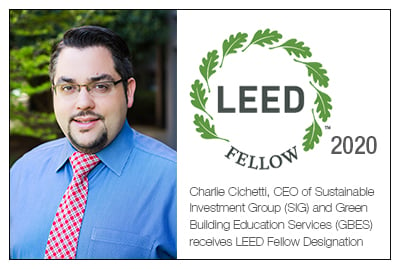
Several SIG team members attended virtual Greenbuild this year, enjoy their top takeaways and insights below. Congratulations to Charlie Cichetti for earning LEED Fellow.
 From Charlie Cichetti,
From Charlie Cichetti,
SIG CEO & Co-Founder
WELL AP + WELL Faculty
LEED AP BD+C, ID+C, O+M, ND, Homes
- The push for going ALL electric on not just New Construction buildings but even retrofitting Existing Buildings
- When planning a new project, more than ever you have to calculate the EV charging infrastructure because that can actually make it harder to get to Net Zero
- Mahesh is already talking about not just LEED Zero but LEED Positive
- I was really impressed that several sessions talked about social equity…even Asa Posner’s talk where SIG’s client, Monte, really came out strong about the large amount of work there is to do here
- Software – there are so many tools out there for LCA’s and carbon calculations
- At the beginning of the Awards Ceremony, I was really inspired to watch the tribute to Gerald Hines

From Danielle Wilmot,
Manager, SIG Special Programs
LEED Green Associate, EIT
- As the push toward electrification moves onward (and as the grid gets greener in many places), there’s more emphasis on not just net zero energy buildings, but specifically, zero carbon. These calculations involve not only operational carbon, but embodied carbon as well – tools like EC3 are out there to help with this, but documentation via EPDs can be a challenge. But to avoid a catastrophic global warming point of no return, we can’t ignore other carbon sources (scope 2 & 3 emissions).
- I was also impressed by the emphasis on social equity, and the reinforcement of the idea that climate change and social injustice are not separate, independent problems – underserved communities are also the most impacted by the effects of climate change, and the building industry has a responsibility to help end that inequity. This is the focus of the new LEED All In program (which USGBC is actively seeking feedback and help on).
- I was also interested to see demos of a lot of the tools out there, many of which are free to use. As the Innovation team moves forward, we’ll need to make sure to do adequate research to find opportunities for both partnership/collaboration as well as competition.
- We need to look into how TrueCarbon could be used in the SITES certification program (and others).
- I have known this for a while and have remained stubbornly in denial, but I need to give up my love for gas stoves. This has been a particular issue recently as Ed and I have been apartment hunting. (Fire is just so much better for cooking! But sigh, I can learn to adjust to induction. I will never cook on a conventional electric range if I can avoid it, though.)

From Asa Posner,
Senior Sustainability Manager
LEED AP BD+C, O+M
- LCA tools we need to be more familiar with: Athena, Tally, One Click LCA, eTool
- EC3 tool for “Procurement of Low Carbon Construction Materials” pilot credit
- EC3 allows you to compare materials that have published EPDs
- Lots of discussions on decarbonization and electrification.
- LEED v4.1 MR updates:
- Dropped “BPDO” name from BPDO credits
- Greater clarity on requirements for EPD Option 2
- Focus on waste prevention: streamlining compliance instead of 75% C&D diversion rate
- Interior life-cycle optimization: Interiors LCA pathway + design for flexibility/disassembly
- Small Commercial Building Energy Saver (CBES.lbl.gov) – free tool that won an R&D 100 Award

From Dallas Terry,
Senior Energy Consultant
CEM, LEED AP BD+C
- Zero Net Energy and Zero Net Carbon dominated the conference and session themes; key topics within this them included:
- A greater understanding of the pathway(s) to building level ZNE/ZNC is becoming more established (i.e. Benchmark/Set Target/Integrated Design/Verify/Monitor, etc…electrification with heat pumps) and the number of success stories and case studies is increasing
- There is still not as much focus on decarbonizing entire portfolios and the cost impacts of doing so compared to
- An increased focus on Embodied Carbon Emissions in the ZNC field and lots of resources and free tools out there to help organizations think more about this
- A greater acknowledgement of the need and potential to decarbonize existing buildings
- A big opportunity for more advanced and frequent energy modeling to help clients understand how to get to ZNE
- Local More Energy Utilities are starting to get more involved in this area, for example Consumer’s Energy in Michigan now has an incentive program for ZNE projects
- Health and Wellness is still a top priority for many organizations with the continued impacts of COVID:
- Professionals are more aware of the potential tradeoffs between things like energy and increased ventilation…people are asking if COVID will slow down progress towards decarbonization goals?
- Lot’s of products and certifications out there to help reduce the spread of pathogens and the risk of disease transmission (i.e. UL, testing, cleaning, etc.); still a big need to educate the market and individual organizations on holistic health and wellness strategies that also incorporate due diligence on these tools and strategies
- There is still not widespread clarity on the complete spectrum of available green building certifications; their pros, cons and respective roles in helping organizations become more sustainable (summary comparative matrices and similar resources are examples of useful tools to help address this issue)

From Lili Yu,
Associate Energy Consultant
- Decarbonization was the most popular topic in Greenbuild 2020 with no doubt. On the utility side, the grid is expected to get cleaner. On the building side, to summarize all the zero-carbon sessions that I joined, I think the main strategies to achieve zero-carbon goal include:
-
- Improve building energy efficiency to reduce the energy demand
- Electrification to emit natural gas use
- Take advantage of renewable energy and enhance energy storage technologies
- Reduce embodied carbon of building materials
- All-electric building design was discussed in more than 2 sessions. Berkeley is the first city that started to enforce new construction to be all-electric last year. Now over 60+ CA local governments are on the way to carry out zero-emissions codes. Two common strategies that I’ve seen in the projects and are also discussed in these sessions are applying heat pump and Induction cooking. The Sierra Club had a study on heat pump feasibility across the U.S. Not many details were revealed. And also concerns about induction cooking were mentioned. It’s not easy for some certain communities to accept this way.
- There are some barriers in promoting all-electric buildings, based on what I heard from the professionals on the real estate side. Their clients have concerns and don’t understand why electrification. One concern is finance. The Building Decarbonization Coalition has made trackers for local incentive/rebate programs available.
- We have been focused on the generation side of renewable energy. Now storage is worth more attention, especially for places with a huge amount of available resources, e.g. some west coast cities and Hawaii with sufficient sunshine. Battery design is still tough. It’s not only about capacity, but also strategies to manage store and release. Energy modeling can generate 8760 hours load data. It can give some insights on how a battery can interact between buildings and the grid.
- Resiliency is another topic I find very interesting to me. Existing zoning code for U.S regions is old. Some professionals and scientists are working on new zoning code considering 7 key challenges of climate change: energy, water, food, waste, mobility, human health and safety, and ecological health.
- Embodied Carbon – move from Operational Carbon to Embodied Carbon
- Improving Indoor Air Quality and it’s effects on human wellness
- Equity – Inclusion of minorities and disadvantaged groups into green building movement
- Improving Construction Materials Transparency and third party product documentation
- Lack of Unified Green Building Standards is hurting our industry. It causes confusion and lack of trust.
- Goals for 2025 – All New Building Construction to be LEED Positive
- Goals for 2050 – All Existing Buildings to be LEED Positive

© 2020 Sustainable Investment Group (SIG). All rights reserved.




